Related Research Articles
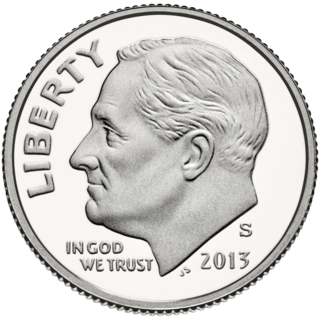
The dime, in United States usage, is a ten-cent coin, one tenth of a United States dollar, labeled formally as "one dime". The denomination was first authorized by the Coinage Act of 1792.

The American Numismatic Association (ANA) is an organization founded in 1891 by George Francis Heath. Located in Colorado Springs, Colorado, it was formed to advance the knowledge of numismatics along educational, historical, and scientific lines, as well as to enhance interest in the hobby.
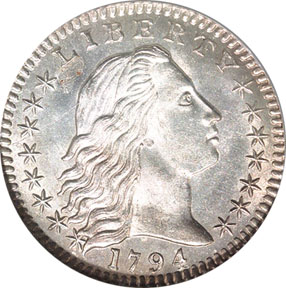
The half dime, or half disme, was a silver coin, valued at five cents, formerly minted in the United States.
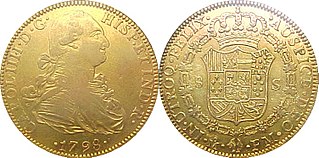
The doubloon was a two-escudo gold coin worth approximately $4 or 32 reales, and weighing 6.766 grams of 22-karat gold . Doubloons were minted in Spain and the viceroyalties of New Spain, Peru, and New Granada. As the Spanish escudo succeeded the heavier gold excelente as the standard Spanish gold coin, the doubloon therefore succeeded the doble excelente or double-ducat denomination.

A pattern coin is a coin which has not been approved for release, but produced to evaluate a proposed coin design. They are often off-metal strike, to proof standard or piedforts. Many coin collectors collect and study pattern coins because of their historical importance. Many of the world's most valuable coins are pattern coins; nearly 25 of the pieces listed in 100 Greatest US Coins are pattern coins.
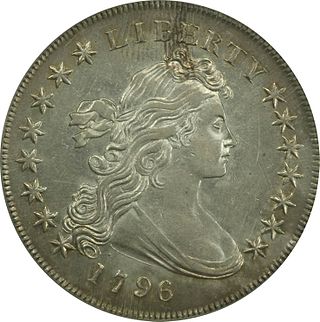
The Draped Bust dollar is a United States dollar coin minted from 1795 to 1803, and was reproduced, dated 1804, into the 1850s. The design succeeded the Flowing Hair dollar, which began mintage in 1794 and was the first silver dollar struck by the United States Mint. The designer is unknown, though the distinction is usually credited to artist Gilbert Stuart. The model is also unknown, though Ann Willing Bingham has been suggested.

The Flowing Hair dollar was the first dollar coin issued by the United States federal government. The coin was minted in 1794 and 1795; its size and weight were based on the Spanish dollar, which was popular in trade throughout the Americas.

The 1913 Liberty Head nickel is an American five-cent piece which was produced in extremely limited quantities unauthorized by the United States Mint, making it one of the best-known and most coveted rarities in American numismatics. In 1972, one specimen of the five cent coin became the first coin to sell for over US$100,000; in 1996, another specimen became the first to sell for over US$1 million. A specimen was sold for US$3 million in a 2004 private sale, then resold for US$3.7 million at a public auction in 2010.

The 1792 half disme is an American silver coin with a face value of five cents which was minted in 1792. Although it is subject to debate as to whether this was intended to be circulating coinage or instead an experimental issue, President George Washington referred to it as "a small beginning" and many of the coins eventually were released into circulation. It is widely considered the first United States coinage struck under authority of the Coinage Act of 1792.

The Brasher Doubloon is a rare American doubloon of eight escudos worth sixteen dollars, privately minted in and after 1787.

The Columbian half dollar is a coin issued by the Bureau of the Mint in 1892 and 1893. The first traditional United States commemorative coin, it was issued both to raise funds for the 1893 World's Columbian Exposition and to mark the quadricentennial of the first voyage to the Americas of Christopher Columbus, whose portrait it bears. The Columbian half dollar was the first American coin to depict a historical person.

Joseph Farran Zerbe was an American coin collector and dealer who was the president of the American Numismatic Association (ANA) in 1908 and 1909. He served as chief numismatist at the World's Fairs in St. Louis (1904), Portland (1905), and San Francisco (1915).

The National Numismatic Collection is the national coin cabinet of the United States. The collection is part of the Smithsonian Institution's National Museum of American History.
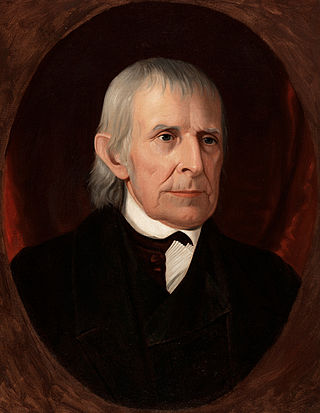
John Adam Eckfeldt was an American worker and official during the first years of the United States Mint. A lifelong Philadelphian, Eckfeldt served as the second chief coiner of the Mint, from 1814 until 1839.

The Turban Head eagle, also known as the Capped Bust eagle, was a ten-dollar gold piece, or eagle, struck by the United States Mint from 1795 to 1804. The piece was designed by Robert Scot, and was the first in the eagle series, which continued until the Mint ceased striking gold coins for circulation in 1933. The common name is a misnomer; Liberty does not wear a turban but a cap, believed by some to be a pileus or Phrygian cap : her hair twisting around the headgear makes it resemble a turban.

Steven L. Contursi is an American businessman and numismatist. He is the founder and president of Rare Coin Wholesalers. In the past 38 years, Steve Contursi has bought and sold over $1 billion worth of rare United States coins.
Flowing Hair coinage was issued in the United States between 1793 and 1795. The design was used for the first half dime, half dollar, dollar, and the first two large cents.
Blanchard and Company, Inc. is an investment firm specializing in rare coins and precious metals, including gold bars, silver coins and bars, platinum, and palladium.

Benjamin Maximillian Mehl, usually known as B. Max Mehl, was an American dealer in coins, selling them for over half a century. The most prominent dealer in the United States, through much of the first half of the 20th century, he is credited with helping to expand the appeal of coin collecting from a hobby for the wealthy to one enjoyed by many.
References
- 1 2 "Rare Coin Wholesalers". Rarecoinwholesalers.com (official website). Retrieved April 27, 2012.
- ↑ "BBB Business Review: Rare Coin Wholesalers". Los Angeles Better Business Bureau. Retrieved April 27, 2012.
- 1 2 Rare Coin Wholesalers. "Rare Coin Wholesalers". Irvine: Rare Coin Wholesalers, 2010. Print.
- ↑ "1794 silver dollar sells for record $7.85 mn". The Economic Times. May 21, 2010. Archived from the original on October 14, 2012. Retrieved April 27, 2012.
- ↑ Muir, Jennifer. "California Man Makes Largest Single Coin Transaction in U.S. History." The Orange County Register 17 Nov. 2005. Print.
- ↑ Adelson, Andrea. "$3 Million Buys a Coin Held by Geo. Washington." The Laguna Beach Independent 4 Feb. 2005. Print.
- ↑ "Rare Coin Wholesalers. About". Rcw1.com. Retrieved 2012-04-14.
- ↑ Wilson, Amy. "Silver Piece, Golden Potential." OC Register 2 Aug. 2003. Print.
- ↑ Healey, Matthew (May 23, 2010). "$7.85 Million for U.S. Coin, and Extra for a Stamp". The New York Times. Retrieved April 27, 2012.
- ↑ "1794 silver dollar sells for record $7.85 million". MSNBC. May 20, 2010. Archived from the original on May 24, 2010. Retrieved 2012-04-14.
- ↑ Contursi, Steven L. (2011-12-19). "Unique, Early American Brasher Doubloon Gold Coin Sold for Record Price". News.yahoo.com. Retrieved 2012-04-14.
- ↑ "Money Museum receives 1792 Half Disme from California coin dealer". American Numismatic Association. January 25, 2011. Retrieved April 27, 2012.
- ↑ "CONTURSI DONATES 1792 HALF DISME TO ANA MONEY MUSEUM". Coin World. February 13, 2012. Archived from the original on September 10, 2012. Retrieved September 6, 2012.
Additional sources
- "Collector buys coins once given to king". Charleston Daily Mail. Associated Press. November 2, 2005. Archived from the original on March 25, 2016. Retrieved April 27, 2012.